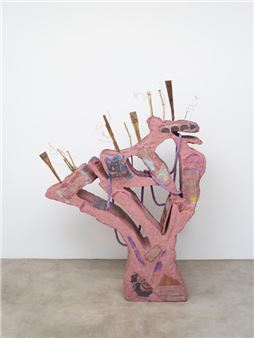MASP Screens Video by Inuk Silis Hoegh on the Transformation of the Landscape in Greenland
In The Green Land, Høegh makes a connection between the meaning of the name of the territory, “green land”, and the current scenario of accelerated glacial melting. The color green represents the contrast between the idea of a fertile land, rich in vegetation, and the changing polar landscape. The video, with its contemplative rhythm, presents different states of the four natural elements––water, fire, earth and air––materialized in different shades of this color, sometimes invading the icy scenery, sometimes integrating into the new landscape.
Curated by Teo Teotonio, Curatorial Assistant, MASP, the work documents the artist’s interventions in the landscape, which consist of inserting various elements in shades of green. By intervening in the territory, Høegh highlights the impact of human activity on ongoing environmental change.
“The color green is used in the work as a potential for transformation, either through the recovery of fauna and flora or through their degradation. Green becomes ambiguous, symbolizing both the fertile and the toxic. By addressing climate change in Greenland, The Green Land not only addresses a local environmental issue, but also highlights the consequences of these changes on a global scale,” says Teo Teotonio.

Recommended for you
In The Green Land, Høegh makes a connection between the meaning of the name of the territory, “green land”, and the current scenario of accelerated glacial melting. The color green represents the contrast between the idea of a fertile land, rich in vegetation, and the changing polar landscape. The video, with its contemplative rhythm, presents different states of the four natural elements––water, fire, earth and air––materialized in different shades of this color, sometimes invading the icy scenery, sometimes integrating into the new landscape.
Curated by Teo Teotonio, Curatorial Assistant, MASP, the work documents the artist’s interventions in the landscape, which consist of inserting various elements in shades of green. By intervening in the territory, Høegh highlights the impact of human activity on ongoing environmental change.
“The color green is used in the work as a potential for transformation, either through the recovery of fauna and flora or through their degradation. Green becomes ambiguous, symbolizing both the fertile and the toxic. By addressing climate change in Greenland, The Green Land not only addresses a local environmental issue, but also highlights the consequences of these changes on a global scale,” says Teo Teotonio.















